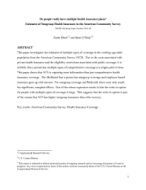Do people really have multiple health insurance plans? Estimates of Nongroup Health Insurance in the American Community Survey
Do people really have multiple health insurance plans? Estimates of Nongroup Health Insurance in the American Community Survey
Abstract
This paper investigates the estimates of multiple types of coverage in the working-age adult population from the American Community Survey (ACS). Due to the costs associated with private health insurance and the eligibility restrictions associated with public coverage, it is unlikely that a person has multiple types of comprehensive coverage at a single point in time. This paper shows that ACS is capturing more information than just comprehensive health insurance coverage. The likelihood that a person has nongroup coverage and employer-based insurance goes up with income. For nongroup coverage and Medicaid, there were only small, but significant, marginal effects. One of the robust regression results is that the write-in option for people with multiple types of coverage is large. This suggests that the write-in option is part of the reason that ACS has higher nongroup insurance than other surveys.
Others in Series
Working Paper
Working Paper
Working Paper




